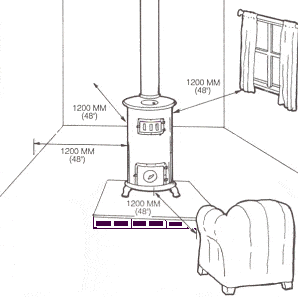WETT Installation check list
This comprehensive check list will guide you through the steps required to install a wood stove to meet WETT Certified Inspections. Answers to the most common questions involving WETT Inspection will be found here.
Is Your Wood Stove a Certified Appliance?
The first step when buying or installing a wood stove is to determine if the appliance is certified by an accredited
laboratory. The most common certification labs are CSA, Underwriters Laboratory (ULC), Warnock Hersey, and OMNI testing Laboratories. They will have a sticker on the appliance
(usually on the back) that specifies the required clearances around the stove. This certification also comes into play in a few other aspects of the installation including stove pipes.
Before the system is installed:
- Check with your municipal building department to see if a building permit is needed. Some municipalities require that you get a building permit to exchange an older stove for a new one.
- Contact your insurance agent to find out if the installation will affect your premiums. If there will be an increase you think is too high, shop around. Insurance company treatment of wood heat installations varies widely.
- Spend some time with your retailer, installer or contractor going over the plans for the installation. Make sure you understand what is involved and what the cost will be. If you are installing the unit yourself, get advice from a trained professional on any points for which you need help.
- Read the manufacturer’s installation instructions carefully.
While the system is being installed:
- Satisfy yourself that the manufacturer’s instructions are being followed exactly. Most installation manuals are very comprehensive and detailed. If the installer deviates from the instructions, ask why.
After the installation is completed:
- Check the installation over to be sure it meets manufactures installation requirements.
- Have the installation inspected by your municipal building department. Some municipal building and fire departments are reluctant to inspect wood heat systems. In some cases these departments will refer you to a local retailer, installer or chimney sweep for inspection. Ask all service people for a certificate of qualification from either WETT, or HEARTH, or CSIA, or an equivalent.
- Notify your insurance agent that the installation is complete.
- Install at least one smoke detector on or near the ceiling of the room in which the appliance is installed. A carbon monoxide detector is also a good idea. Replace the unit or its batteries as often as the manufacturer recommends.
- Buy an approved ABC-type fire extinguisher and store it near the installation. Follow the instructions on the extinguisher label for maintenance procedures.
Ember Pad Requirements
Ember protection is required to extend a minimum of 18 inches in front the opening door, and 8 inches beyond the appliance on the other sides. Construction of the ember pad could be ceramic tile, that is grouted, or sheet metal of a minimum thickness of 0.38 mm.
Floor Protection – Most modern wood stoves do not require Floor Protection as unit is designed to meet acceptable clearance from floor.
Every wood stove is required to have proper floor protection, which is determined by B365 Installation Code for Solid Fuel Burning Appliances and Equipment. Your appliance would be exempt  from these requirements if it was installed on a concrete floor. Not having the required floor protection can endanger you and your family. Often during WETT Inspections we often find improper or damaged floor protection around space heaters.
from these requirements if it was installed on a concrete floor. Not having the required floor protection can endanger you and your family. Often during WETT Inspections we often find improper or damaged floor protection around space heaters.
We provide WETT Certified Inspections to Innisfil and most of Simcoe County
Call Roger at 705-795-8255 to book an inspection or for more information.